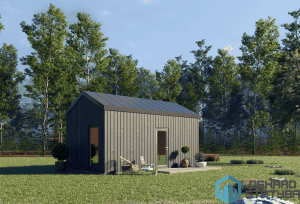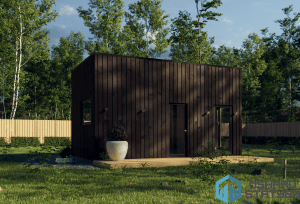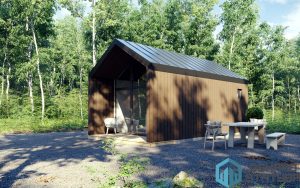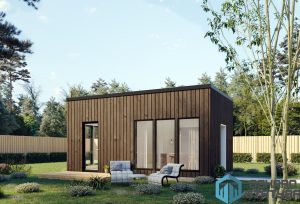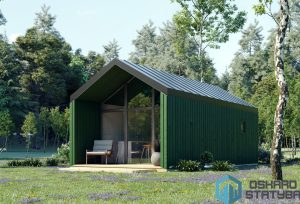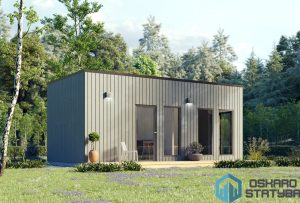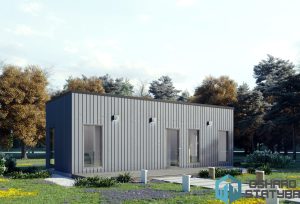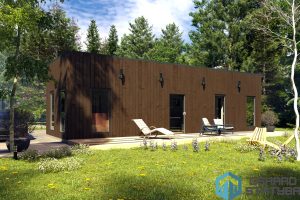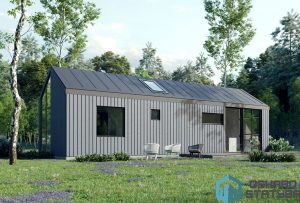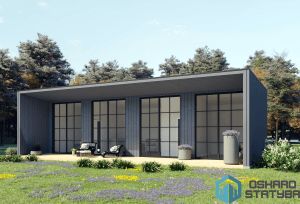Residential garden houses are perfect for year-round living, provided that the main parts of the house – the floor, walls, and roof – are insulated with high-quality insulation materials.
To make a garden shed suitable for living in the winter, it is important to ensure: good thermal insulation to reduce heat loss, a reliable heating system to maintain the optimal temperature in the house, and proper ventilation to prevent moisture and mold.
The modular homes we offer are fully finished, making them suitable for year-round living.
If you are looking for someone who can prepare and implement a garden shed project based on your wishes, contact us and in just a few months you will be able to enjoy a comfortable garden shed with all the amenities.
Oskarostatyba.lt offers modular garden houses with the following features:
- High-quality insulation for optimal comfort even in the coldest conditions.
- A reliable heating system – air-to-air heat pumps and other solutions will ensure sufficient heat throughout the year.
- Fast construction – the use of prefabricated modules in the construction process will allow you to build a garden house faster and cheaper than a traditional house.
- Personalized solutions – if necessary, we can adapt the house project to your specific needs.
- Lower cost – standardized components and pre-manufacturing of modules in the factory allow for a significant reduction in the final construction cost.
How is a garden shed insulated so that it can be lived in during the cold season?
To make living in a garden house comfortable even in winter, it is important to properly insulate the future structure and choose high-quality construction materials.
It is usually recommended to choose a wall, roof and floor panel with a thickness of at least 20 centimeters, which will ensure sufficient thermal insulation.
The correct choice of heating source will be no less important. The most commonly used combined heating: a heat pump air-to-air system combined with infrared mats, which is efficient and economical.
If the needs are not large, simpler heating solutions such as electric heaters or radiators can be chosen, but they will not be able to offer the same efficiency as a combined system.
What are the main materials used for insulation?
Mineral wool
Mineral wool is a popular insulation material, valued for its excellent thermal insulation properties and fire resistance. It also absorbs sound well, making it ideal for use in garden sheds to ensure adequate comfort for residents.
Polystyrene
Polystyrene, including EPS (expanded polystyrene) and XPS (extruded polystyrene), is a lightweight, highly effective insulation material. It has high moisture resistance, making it an excellent choice for exterior insulation.
Spray foam
Spray foam provides excellent insulation because it can fill even the smallest gaps and cavities. This material provides a seamless layer of insulation that helps prevent heat loss and cold air from penetrating.
What heating system is most efficient in a garden shed?
The choice of heating system and its efficiency largely depends on the chosen insulation solutions and their quality. Even the best heating system will not achieve the desired results if the house is not properly insulated.
Therefore, before making a final decision, it is important to consult with specialists who will help assess what insulation is needed in the house and offer the optimal heating solution that meets your needs and climatic conditions.
Some popular heating solutions for a garden shed are:
| Heating system | Features |
| Air-to-air heat pumps | Energy efficient, heats up rooms quickly. Can also act as an air conditioner in the warm season. Disadvantages: higher initial investment and lower efficiency on very cold days. |
| Electric heaters | Easy to install and inexpensive, they heat a room fairly quickly. However, their operating costs can be higher if the garden shed is not well insulated, so they are more suitable as a supplemental heating source. |
| Electric radiators | Easy to install and portable. Can be used as a primary or secondary heating source. Less efficient in larger spaces, can have relatively high operating costs. |
| Fireplaces/Stoves | Traditional, cozy home atmosphere. Independent of the electricity grid, therefore suitable as a main heating source. Disadvantages – require constant maintenance and fuel, can heat rooms unevenly. |
How to prevent dampness and mold in a garden shed during winter?
To avoid moisture and mold problems, it is very important to ensure proper ventilation and temperature control in the premises.
The most effective measures to combat this problem will be a high-quality mechanical ventilation system (recuperator) or regular natural ventilation of the premises so that air can circulate freely and moisture does not accumulate.
It is also worth making sure that the walls, floor and roof of the cabin are properly insulated to avoid temperature fluctuations that can cause condensation. It is important to regularly monitor the humidity level in the cabin and, if necessary, use additional dehumidifiers.



